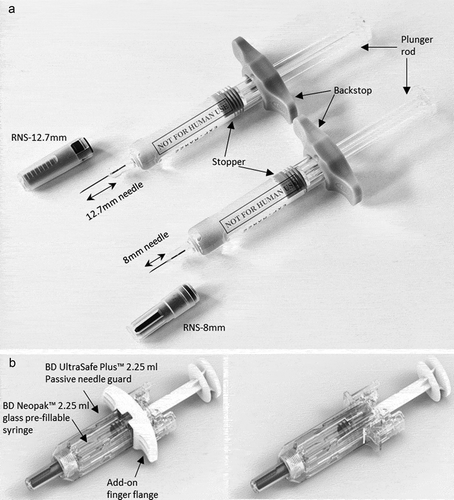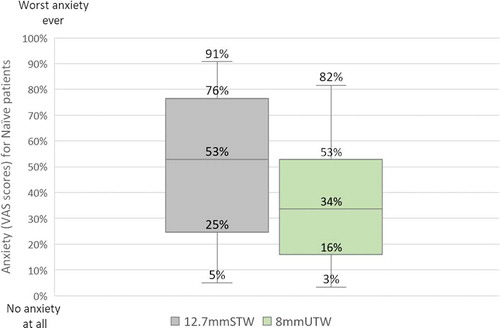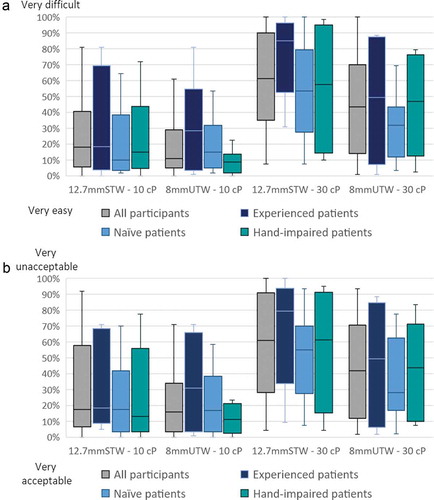Figures & data
Figure 1. (a). BD Neopak™ 2.25 mL glass pre-fillable syringe with special thin-wall 12.7 mm (left) and ultra thin-wall 8 mm (right) needles. (b). BD UltraSafe Plus™ 2.25 mL Passive needle guard combined with BD Neopak™ 2.25 mL glass pre-fillable syringes with special thin-wall 12.7 mm needle with (left panel) and without the Add-on finger flange (right panel)

Table 1. Demographic characteristics of the participants
Figure 2. Boxplot distributions of the VAS rating of the anxiety perceived by naive self-injecting patients during the formative study. Horizontal lines indicate median values, boxes indicate interquartile range, and whiskers indicate minimum and maximum values. VAS scale ranging from 0% = no anxiety at all to 100% = worst anxiety ever

Table 2. Estimated risks of intradermal (ID) and intramuscular (IM) injections with the 8mmUTW and the 12.7mmSTW syringes per site of injection and angle of insertion. The percentage of reduction in IM and ID risks and the risk ratio comparing the 8mmUTW and 12.7mmSTW syringes were calculated. N = 500 sample size. Percentages and risk ratio values are rounded up
Figure 3. Usability of 8mmUTW and 12.7mmSTW syringes during the formative study. Overall task completion rates (a) and per task assessed (b). Success, use error and success with operational difficulty (SOD) rates are indicated for syringes filled with 2 mL of 10 cP solution. N number of simulated injections; %. (c). Success, use error and success with operational difficulty (SOD) rates are indicated for syringes filled with 2 mL of 30 cP solution. N number of simulated injections; %. * 71% (for 12.7mmSTW) and 83% (for 8mmUTW) of the use errors were caused by syringe priming. (d) Rates of success, use error, and artifact in regard to the injection technique used by patients. N number of simulated injections; %

Figure 4. Boxplot distribution of the VAS scores of the ease of pushing the plunger rod (a) and of the acceptance of the force required to push the plunger rod (b) for all participants of the formative study. Horizontal lines indicate median values, boxes indicate interquartile range, and whiskers indicate minimum and maximum values. VAS scales ranging from 0 = very easy/very acceptable to 100% = very difficult/very unacceptable

Table 3. Preferred syringe between the 8mmUTW and the 12.7mmSTW during the formative study when both filled with 10 cP and 30 cP solutions across all participants. N number of answers; (%)
Figure 5. Usability of the safety X225 PLUS device equipped either with the 8mmUTW or the 12.7mmSTW syringes during the validation study. Overall task completion rates (a) and per task assessed (b) for X225 PLUS–8mmUTW and X225 PLUS–12.7mmSTW devices. Rates of success, use error and success with operational difficulty (SOD) are indicated. N number of simulated injections; %. * 20% (for X225-12.7mmSTW) and 28% (for X225PLUS-8mmUTW) of the use errors were caused by syringe priming. Ease of pushing the plunger rod (c) and acceptance of the force required to push the plunger rod (d) for X225 PLUS–8mmUTW and X225 PLUS–12.7mmSTW products. N represents the number of answers rated at 5 (easy/acceptable) and 6 (very easy/very acceptable); (%)

Table 4. Willingness to adopt the X225 PLUS–8mmUTW and the X225 PLUS–12.7mmSTW products across all participants during the validation study. N number of answers(%)
